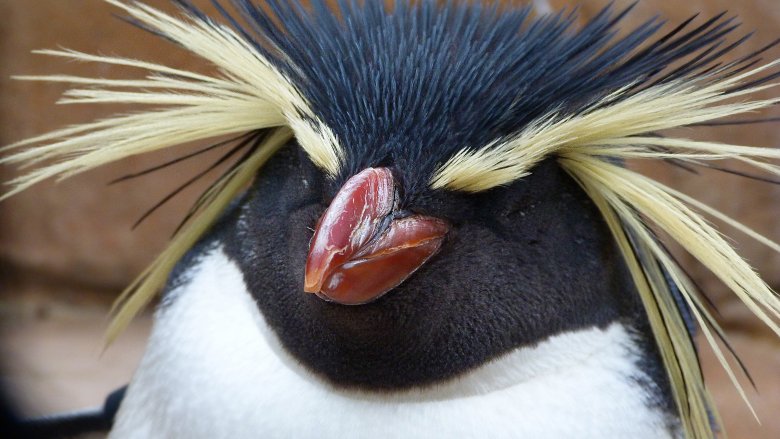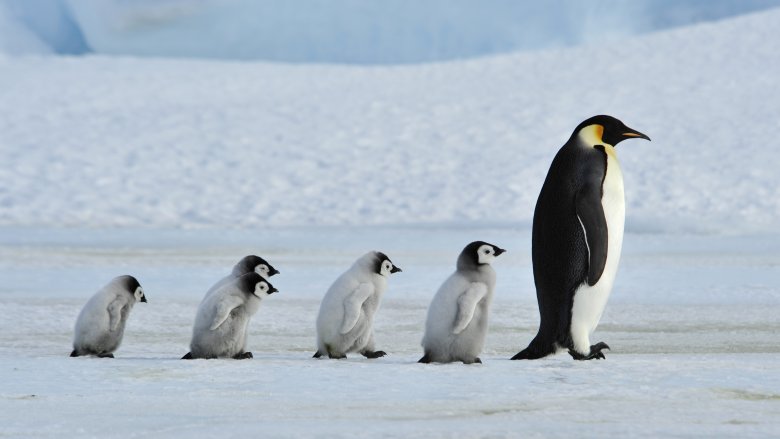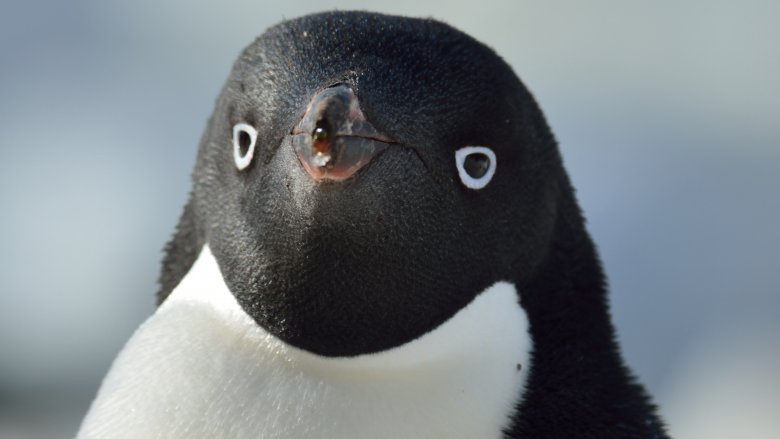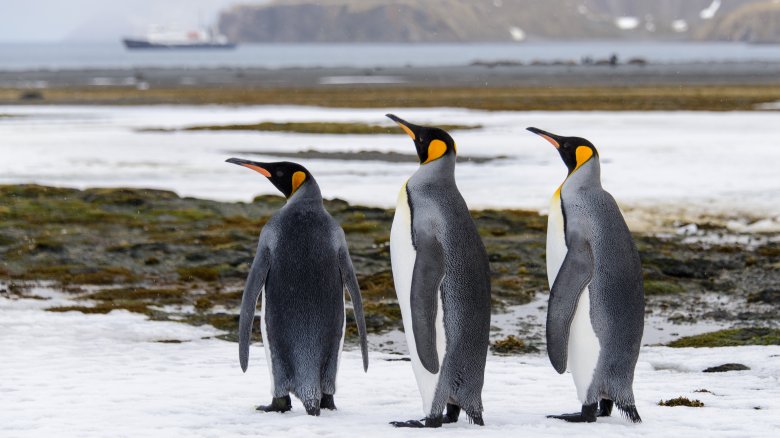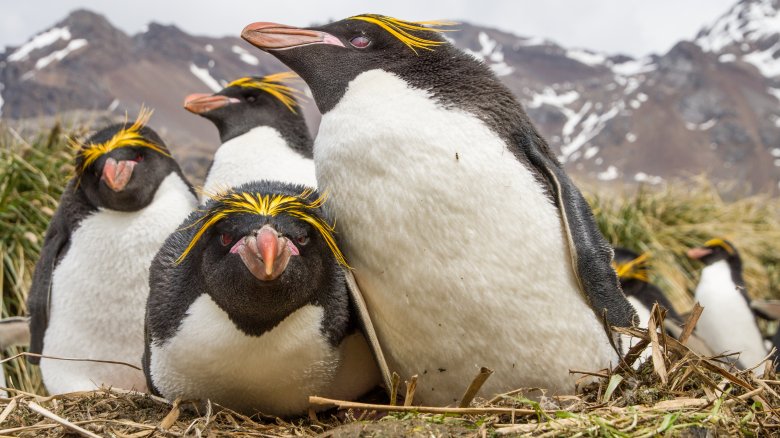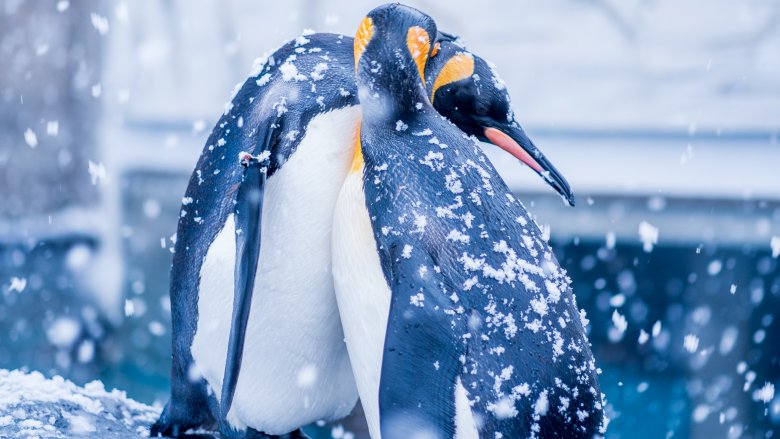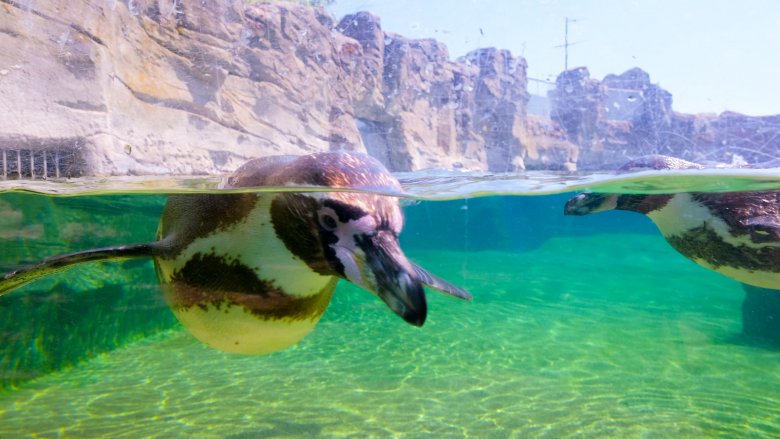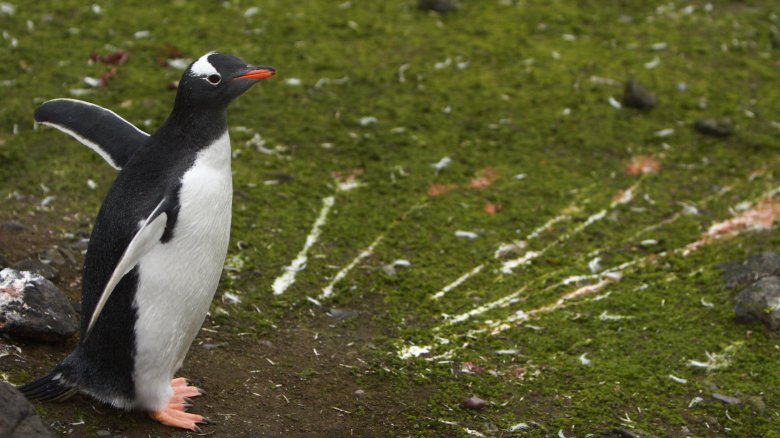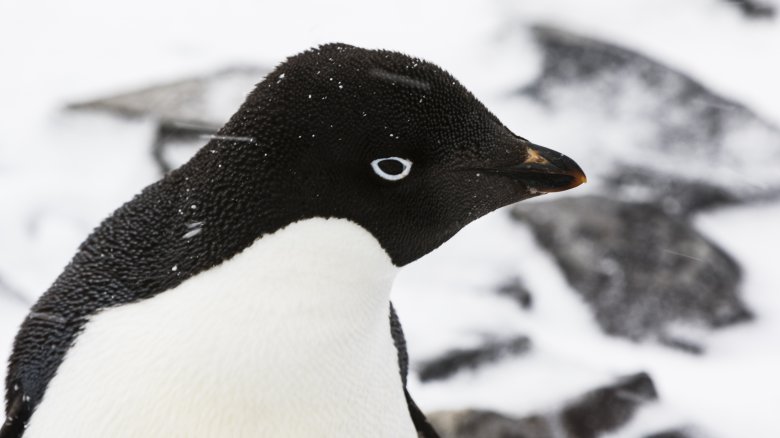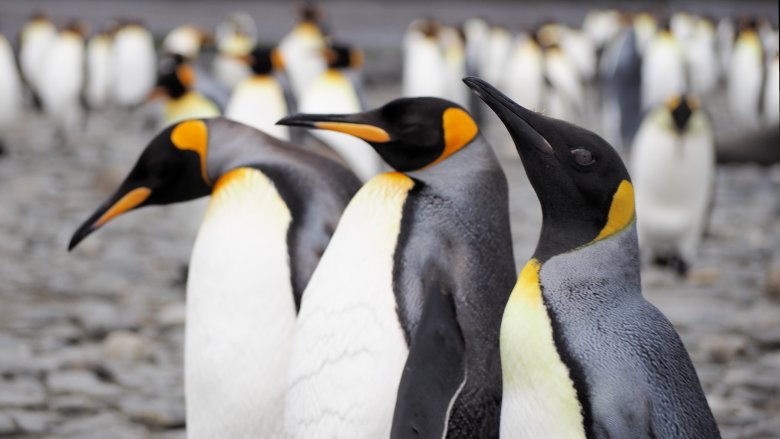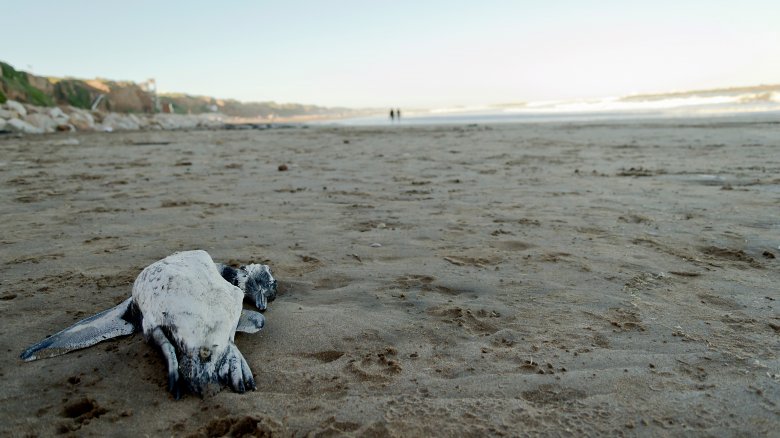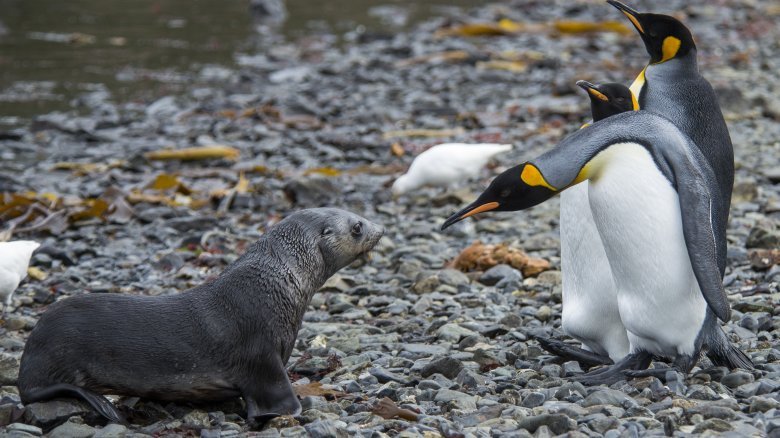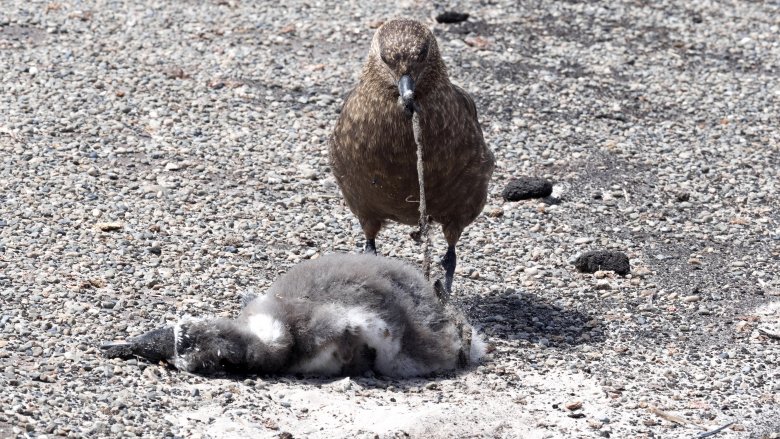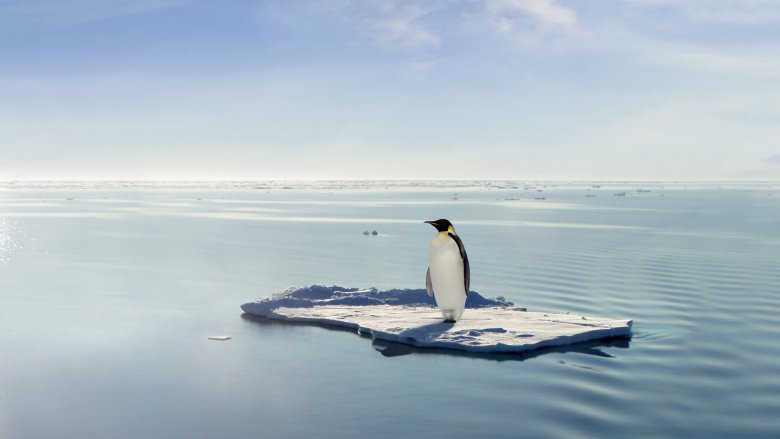Why It Sucks To Be A Penguin
Cute comedy animals are awesome, and no animal is cuter or more comedic than the penguin. Just check this little guy: waddling around in his nature-bestowed tuxedo, flapping his adorable little flippers, sliding around on his belly like a drunk guy who's fallen over poolside at a barbecue. What's not to love?
Plenty, as it turns out. Friends, our little penguin buddy has a secret. One he is sworn to keep schtum lest those sweet Disney residuals checks from March of the Penguins ever stop rolling in. Being a penguin absolutely sucks. It sucks to the point that, if our poor guy could choose, he'd probably rather be a Misery Worm or a Depression Slug than an adorably unhappy penguin. We're betting Pingu never had to put up with any of this stuff.
The constant threat of child abduction
Nature is all about two things: feeding and breeding. When an animal can't tick off one of those things (or, in the case of those spiders that devour their mate, both at once), they tend to go a bit nutty. Where penguins are concerned, this nuttiness manifests itself less as Nutty Professor-style amusing quirkiness, and more as Nutty Professor II: the Klumps-style screaming brain farts. If a female emperor penguin can't procreate, she'll sometimes resort to stealing a chick from another penguin to satisfy her mothering instincts.
As National Geographic details, this ordeal is even less fun for the chick than it sounds. If being snatched away from its mother wasn't enough, the kidnapper eventually flips out and loses interest, abandoning the stolen chick after a few days at most. Know what happens to a defenseless baby chick when you abandon it in the middle of Antarctica? To paraphrase the worst movie line in history: same thing that happens to everything else. It dies. Horribly.
There's a biological reason for this that goes beyond simple sadism. According to National Geographic, birds produce a hormone known as prolactin when they lay an egg that makes their parental instincts kick in. Usually, removing the egg removes the hormone, but not in emperor penguins. Bereaved penguin moms are still full of chemicals demanding they mother something, so they just grab the closest chick. It'd almost be touching if it didn't end in infanticide.
You're surrounded by depraved sex offenders
In 1911, Englishman George Murray Levick spent an entire breeding season studying Antarctica's Adélie penguins. According to a report from The Guardian, what he saw of penguin breeding season was utterly perverted. Levick witnessed so much sexual horror that he wrote his notes in Greek so only other educated gentlemen would ever become privy to the nightmares within.
A Slate article goes into greater detail. Levick saw stuff that we can only assume documentary producers regularly leave on the cutting room floor. Aroused males would force themselves on other male penguins. They would mate with chicks, occasionally killing them. And they had a barf-inducing attraction to dead females. Levick recorded Adélie males ejaculating on frozen corpses, including those of females who had died the previous year. Other penguins attempted to have sex with the ground. If there really is a hell, it probably looks a whole lot like an Adélie penguin mating season.
Scientists have since tried to quantify exactly where penguins will draw the sexual line, and the answer is "approximately 2,000 miles beyond the point where humans would." Ornithologist Douglas Russell with the London Natural History Museum — who must write the strangest research proposals in the entire world — has discovered that the frozen head of a female penguin, propped up on a rock with its eyes removed, is enough to act as a "come hither" invitation to horny Adélie males.
You might get turned into a lamp
In the annals of tragic-yet-hilarious things that have befallen penguins, none manages to be either quite so tragic or quite so hilarious as what befell the king penguins of Macquarie Island (as told in New Scientist).
A thin piece of cigar-shaped rock halfway between Antarctica and Australia, Macquarie Island leaped to fame in 1919, following a campaign to expose the misdeeds of Joseph Hatch. An alumnus of the Saturday morning cartoon school of villainy, Hatch had discovered you could get oil for lamps by boiling king penguins. So boil them he did. Over three million of them.
At its height, Hatch's Macquarie Island "factory" had metal penguin digesters working round the clock to boil the fat off penguins, netting Hatch a fortune. It also brought him to international notoriety, sparking one of the world's first wildlife campaigns. When Hatch was shut down in 1919, only 4,000 penguins were left on the island. They wouldn't last long.
Visitors to Macquarie Island in the time of the campaign had unwittingly brought rats with them. With Hatch gone, the rats now ran wild, endangering the already-endangered penguins. So people bought cats over to catch the rats. The cats killed both the rats and the by-now-probably-very-fed-up penguins. So humans killed the cats, which in turn caused the island's rabbit population to explode. The rabbits ate the long grass the penguins laid their eggs in, leading to — you've guessed it — yet more penguin deaths. That's why invasive species are bad, kids.
Being a monogamous animal in the wild is horrifying
A whole bunch of penguin species mate with their partner for life. This means they spend the whole breeding season together, then hook back up at the start of the next breeding season to repeat the cycle all over again. What a fantastic advert for good, clean, monogamous living.
Not quite. Being a monogamous animal in the wild is very different from being a married human. You spend the majority of the year apart, but once breeding season rolls back around, you have to return to your nesting site and hope your partner is waiting for you. "Hope" is the operative word. In Partnerships in Birds, a collection of scientific essays, biologist Tony D. Williams writes that penguin couples only hook back up around 58 percent of the time. The other times, one penguin usually returns to the nest to find their partner died in the meantime.
Imagine if humans had to live that life. Imagine if, every time you went out to work, there was a chance you might come back to find your husband or wife had frozen to death or been eaten by a killer whale. That's the depressing yearly ritual penguins have to deal with.
Interestingly, loss of a partner affected different penguin species and genders in different ways. While nearly all male gentoo penguins found new mates, only 64 percent of female gentoos did. On the other hand, most female macaroni penguins (pictured) brushed off a partner's death, while nearly 40 percent of males remained single.
The temperature always sucks
There is a reason barely any humans try to live on Antarctica, and that reason is that Antarctica's weather sucks. In the winter, it gets cold enough to crack human teeth (via The Telegraph). As emperor penguins live there, you might expect them to have evolved to enjoy such miserable conditions. You'd be wrong. Emperor penguins spend almost their entire lives in temperatures seemingly designed to make them miserable.
First, the cold of Antarctica in winter is so brutal that even animals that choose to live in it are in extreme danger of death. To combat this, emperor penguin colonies have leaned to form a gigantic huddle, pressing against others to warm up with body heat. The huddle is always shifting, giving those on the freezing outside a chance to stand in the warm core. That's the second problem: heat. The inside of the huddle is over 99.5 degrees Fahrenheit. As the BBC reports, that's enough to make a penguin badly overheat. So the penguins keep rotating, spending the entire winter oscillating wildly between being way too cold and being dangerously hot.
So what about the Antarctic summer? Actually, that also sucks. Temperatures of 63 degrees Fahrenheit are enough to put king penguins in danger of overheating (again via BBC). Basically, penguins are forced to spend their lives like Goldilocks' first two bowls of badly cooked porridge, without ever finding the "just right" spot they must be desperately craving.
Penguins smell terrible
When you visit penguins at the zoo, they're usually behind glass, and there's a good reason for that. Penguins stink. They smell so awful that NPR described a whiff of penguin guano like this: "Take some old cigarette tobacco, soak it in ammonia, mix in some rotten shrimp, and let it sit out in the sun for a few days." Yum.
Now imagine that smell rising from a patch of rocks a quarter mile long and occupied by thousands of penguins. It is a smell more powerful than a 16-year-old boy's sneakers and more resilient than the stink of a buck goat that has also recently been sprayed by an entire family of ill-tempered skunks. If you stand on just the right mountaintop on a warm summer evening, maybe you can smell it wafting all the way up from Antarctica.
Despite the horrible stink, which is so overwhelming that a mere human can distinguish nothing but horror, penguins are actually able to discern the individual odors of family members, which helps prevent inbreeding. The unique scent of each bird comes from its preen gland, which contains water-repellent oils that it can rub on its feathers. Each penguin's oil smells a little bit different, and since they're pretty much saturated with it, other penguins can somehow filter out the stomach-churning stench of the layers of guano and use it as a unique identifier.
Penguins poop so much that it can be seen from space
We have established that penguin poop smells, and that there is a lot of it. Also, chinstrap penguins can projectile poop at a distance of up to 16 inches. This seems bizarre until you consider the distinct advantage these suborbital launches have: When you're incubating your eggs, you don't want to leave them alone while you wander down to the outhouse, and you certainly don't want to be dirtying up your own nest. So when the need strikes, it's pretty handy if you can just evacuate your leavings out the front door.
And we have even more fun facts to share about penguin poop — according to the BBC, a large colony of penguins will crap so much that you can actually see it from space. And that's not just a cool piece of trivia. Scientists can use satellite observations of penguin scat to determine things like what species created it, how many chicks are in the colony, where they've moved over time, and how many penguins there are in total.
Now, studying animal doodoo is not a new thing, and it's been used for decades to help biologists understand what animals eat and where they like to go. But when there's so much of it that you can make scientific observations about it from outer space, well, that's a lot of poop.
Penguin prostitution is real
If an Englishman's home is his castle, then an Adélie penguin's nest is probably her boudoir. Every mating season, Adélie colonies in Antarctica engage in a mad scramble to build the biggest and bestest nests possible from the loose stones surrounding their colony. Males get in bloody fights. Stones are stolen. Adorable chaos reigns.
Penguin couples that fail to build a large nest are at a much higher risk of losing their eggs to floods, so there are real stakes in this continent-wide penguin brawl. Which may explain why Adélie females will go to such extreme lengths to secure stones. According to an article that appeared in the American Ornithological Society's journal The Auk, female penguins will often engage in sexual acts in return for a male's stones. In other words, penguin prostitution is totally real and it happens all the time.
The researchers tracked ten female penguins who slipped away from their male partners, found a single male with his own nest, and offered themselves to him. In all ten cases, the single male mounted the females. In all nine cases where sex wasn't interrupted, the female picked up a stone afterward and took it back to her own nest. Half of the females returned for a second stone, with one female coming back ten whole times. Each time, the single males did nothing to stop them. In most cases, the female then returned to her original mate with the extra stones like nothing had happened.
Mortality rates are insane
The quote goes that nature is red in tooth and claw, meaning the natural world is far more savage and far less cuddly than we'd like to believe. In a minute, you'll start calling nature "red in tooth and flipper." Even the most pessimistic cynics would be shocked by the unbelievable mortality rates wild penguins suffer.
The statistics come from SeaWorld's website, where they're presented in gentle, pastel hues that completely contrast with the bleak truth they reveal. Simply by being a penguin and alive, our flippered friends are beating some stark odds. These odds include African penguins having 40 percent of their eggs eaten, or king penguins (pictured) losing up to 50 percent of their chicks due to winter starvation. Even these grim tallies have nothing on the emperor penguin. If you're an emperor penguin in your first year (and if you are, that's some impressive internet skills, bud) you have a 90 percent chance of not seeing your second birthday.
For comparison, SeaWorld gives wild harbor seals a 21 percent first-year mortality rate. It gives wild orcas a 50 percent rate — the same as king penguins — while noting it's "very high." A report covered in Reuters gives polar bear cubs a 45 percent rate. Notice how all these examples are well shy of 90 percent? Being an emperor penguin is as good for your long-term health prospects as lying down for a nap on the interstate.
Antarctica is covered with the mummified bodies of dead penguins
The thing about living and dying in a place where it's so freaking cold that shivering is literally a diet and exercise program is that you're surrounded by death. Not just the kind of death where you get hit on the head by a collapsing glacier or an ice sheet rolls over you while you're sleeping, but pretty much every kind of death. Because despite the formal wear, there are no penguin morticians, no penguin funeral homes, and no penguin-sized shovels that would be useless anyway because the ground is so frozen you can't dig holes in it.
Just like the "kill zone" near the summit of Mount Everest, only without all the colorful climbing attire, Antarctica is littered with the mummified corpses of those who didn't make it. According to LiveScience, the very cold and dry conditions in Antarctica are perfect for mummification, and in 2016 scientists found a whole "graveyard" full of nicely preserved penguin corpses, which they think are the remains of a climate-related die-off.
The bodies are either 750 or 200 years old, which indicates there were two separate incidents. Scientists used ancient poop and nesting material to somehow figure out that the die-offs were caused by heavy precipitation during an unusually warm season. So now we have a tidy little snapshot of what might be in store for penguins if the climate keeps warming. And also a promising opening scene for an unconventional mummy movie.
The increasing threat of interspecies sexual assault
Since 2006, scientists in the sub-Antarctic region have noticed a disturbing — if rare — new trend involving penguins. Fur seals have been recorded mounting and forcibly trying to mate with the birds, often injuring them in the process. The bizarre phenomenon was reported in Polar Biology (via the BBC).
The assaults took place between 2006 and 2011 on Marion Island, a desolate hunk of rock some 1,300 miles south of South Africa. Each time, scientists stationed on the island watched, presumably in horror, as male fur seals chased down, jumped on top of, and tried to have sex with penguins. Reading the details provides a surefire cure for being able to keep your lunch down. In some cases, the seals actually managed to penetrate the penguin's cloaca, a kind of one-stop shop for pooping, peeing, and mating. In one grisly incident, the seal finished himself off then ate his victim, which sounds like the pitch for an Animal Planet documentary directed by Eli Roth.
The most disturbing part of this wholly disturbing report is that fur seals are good learners. They watch what others do and copy them. After the first seal assaulted the first penguin in 2006, others got in on the act. The more that do it, the more likely it is to become a learned behavior that sticks around. What any of the species involved — seal, penguin, or human — get out of it aside from "nightmares" is something science sadly can't answer.
You have to deal with the skua
Animals in the wild eat other animals. No surprise. But there's eating other animals to survive, and then there's torturing and murdering them like a total butthead. The south polar skua fits into the latter category. A boring-looking seabird, behind the skua's plain outward appearance is a sadistic psychopath.
Even among its own kind, the skua is awful. Conservation site Arkive notes that firstborn skua chicks generally kill their siblings. As adults, skuas steal each other's food mid-flight, a move as impressive as it is jerkish. With non-skuas, they're even worse. Like many animals, south polar skuas eat penguin eggs and chicks. While most predatory birds kill their victims before devouring them, the skua cements its evil reputation by eating penguin babies alive.
The book The Behavior of Penguins describes exactly what this entails in morbid detail. Skuas kill baby chicks by sitting on their backs and chewing off their soft bits as the chicks squawk for help. First they peck out the eyes, then they start eating the head. If the chick is unlucky enough to have been caught by two skuas, it'll have its eyeballs eaten while simultaneously having its cloaca sliced open.
The worst part? The skua is only doing this because it's the dillhole jock of nature's Darwinian high school. To quote the Behavior of Penguins, its methods are "an extremely unspecialized and inefficient way of killing prey," meaning the skua actually damages its own survival prospects just to be a jerk.
The penguin apocalypse is coming
Climate change is due to mess up the entire planet pretty soon. While its effects are predicted to run from "totally un-awesome" to "Arrrgh! Someone please save us!" among humans, among penguins it'll be even worse. Where the two penguin species based in Antarctica are concerned, the Adélie and emperor penguins, it's going to be nothing short of the penguin-pocalypse.
The Woods Hole Oceanographic Institute (WHOI) is one research body that think things will turn out kinda sucky for our feathered friends. In a report released in June 2017 (via Science Daily), WHOI's research team looked at how current warming trends might affect emperor penguin colonies. The answer was "terribly." At the absolute sunniest end of the spectrum, the WHOI team estimated global emperor penguin populations could drop 40 percent by 2100. At the soul-destroying end, they estimated populations could drop by 99 percent. It's hard to be sure exactly how many emperor penguins this would leave, but the answer can probably be expressed as "not many."
Things aren't looking much rosier for the Adélie penguin. A University of Delaware study in 2016 (reported here in National Geographic) claimed the penguins could lose as much as 60 percent of their habitat by 2100, something as harmful to penguins as having your house and hometown replaced by Antarctic wasteland would be to humans. On the other hand, judging by the misery of penguin existence, perhaps they won't actually mind dying out.
